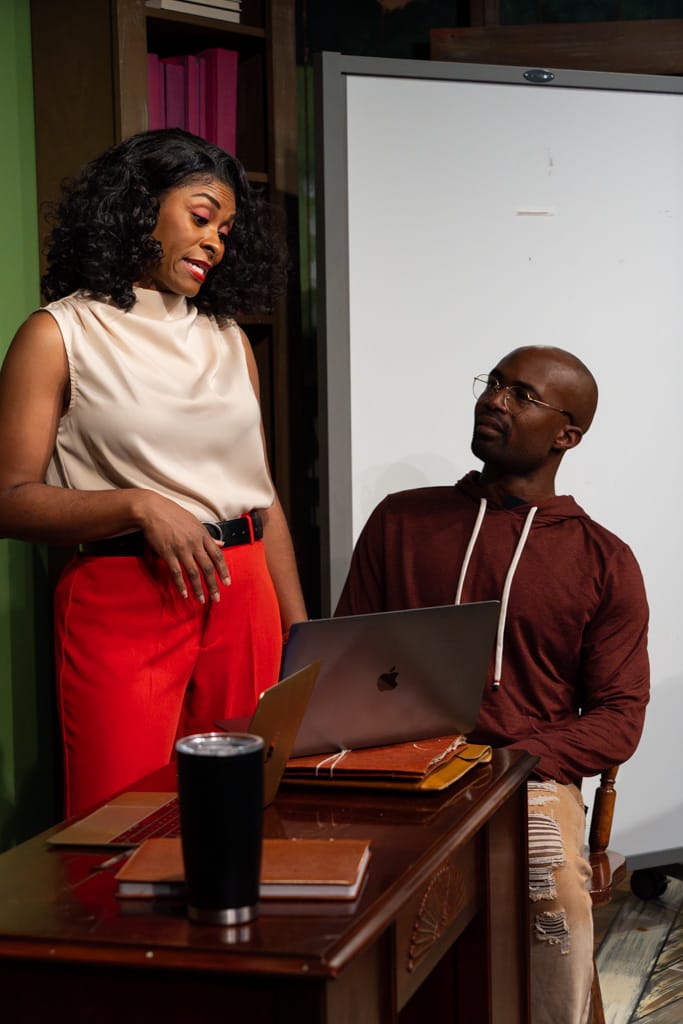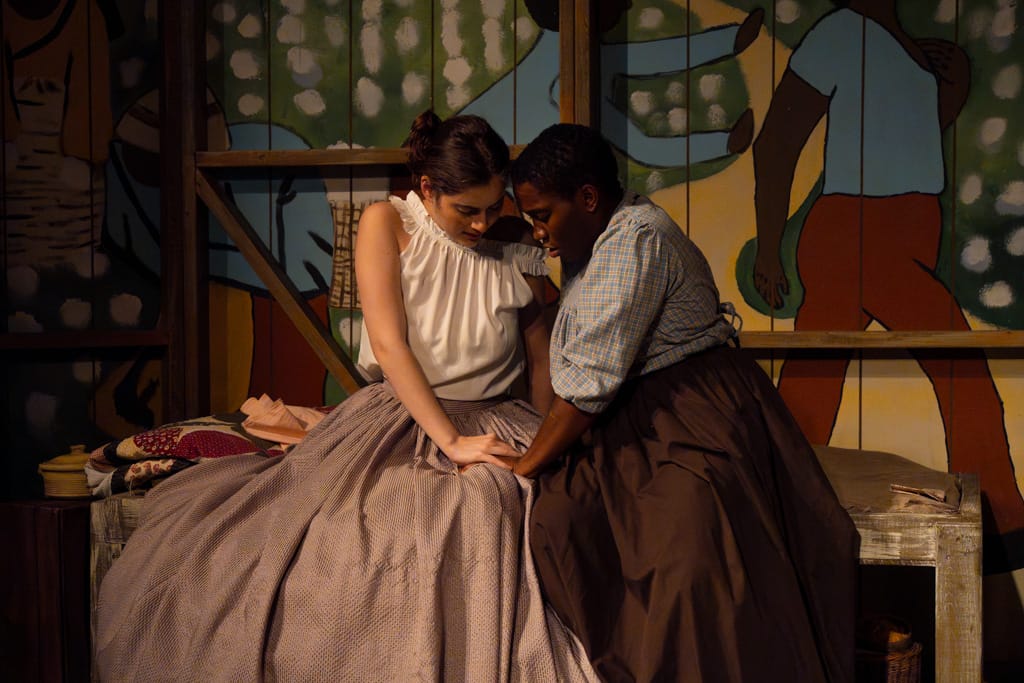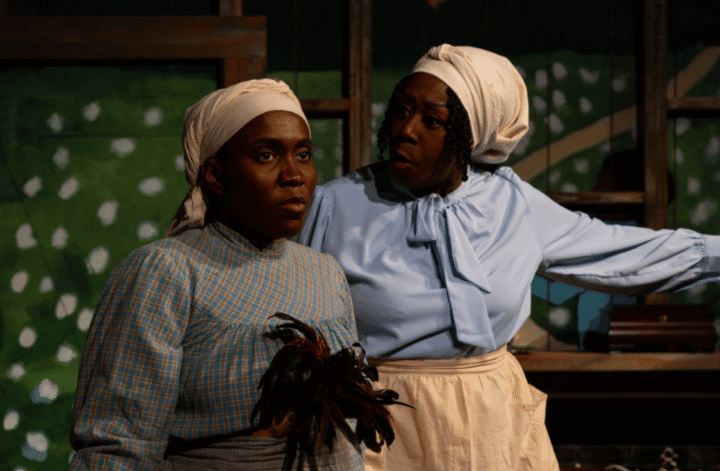“History doesn’t repeat itself, but it often rhymes” is a maxim I’ve been hearing far too often. We live in a world that’s blasting headfirst toward what many see as a sci-fi future … yet also appears to be falling off a societal cliff into our troubling past. The “rhymes” of warning are coming at us at lightning speed – but how many of our populace care about poetry, rhyming or not? How many study history, read essays, think deeply about editorials by distinguished academics and politicos?
Live theater, on the other hand — where everyone of any background can participate in that rare, concentrated bubble of silenced cellphones and communal engagement — has a much better chance of transmitting new ideas while shaking up preconceived notions and prejudices we didn’t even know we had. And dare I say perhaps hitting a nerve, in a “safe place,” where we are allowed (in fact encouraged) to change our minds, learn, and grow into our better selves — i.e. more aware, intelligent, and compassionate human beings.
New City Players (NCP), whose stated vision is “to be a vital public square where stories spark change, artistry shapes understanding, and a diverse ensemble leads the charge toward a more empathetic, curious, and connected society” ends its dynamic 2024-25 Season with the regional premiere of CONFEDERATES by Dominique Morisseau, a McArthur “Genius” grant recipient and active, Tony-nominated playwright. Her 2022 off-Broadway sensation was praised for its incisive commentary and structural innovation, quickly establishing “Confederates” as a major new work in the American canon.
One can always count on New City Players to dive deep into the material and present a uniquely powerful and immersive play experience. If you’re interested in learning more about their artistic process and how this superb ensemble of actors brought their characters to life – individually and together – I highly recommend attending the 3 pm Sunday show that’s followed by an insightful Talkback with cast, director, and some members of the creative team.
This is where I learned how producing artistic director Tim Davis first engaged director Maha McCain 18 months ago … and how she personally related to this play featuring university professors because, in addition to being an active local actor and director, McCain is also a long-time educator. Like McCain, two characters in the play’s contemporary timeline are Black female professors.
The play’s title, “Confederates,” can be interpreted in various ways. Half of the story takes place during the time of the Confederacy. There are two alternating timelines, 160 years apart. One, during the Civil War, and the other, in the present. Both center on the plight and actions of strong female African-American characters, particularly women.
Two enslaved Black women on a Southern plantation during the time of the Civil War are simply trying to survive and, other than being slaves, have little in common. But first one, and then the other, conspire to spy for the Union in hopes of gaining their freedom. Alternately, two Black professors at a major Northern university who are very much in the minority (as are their handful of Black students) clash in teaching style and didactic philosophy but ultimately come together in their fight against bigotry.
All of these characters, in their own way, must deal with systemic racism that’s institutional or even self-inflicted. In both timelines, women who originally mistrust each other, end up coming together to fight for the common cause. They become “confederates”: simply defined as an ally or accomplice, but more comprehensively as someone you work together with in secret, sometimes illegal, activity, united in an alliance or conspiracy. As you’ll see, this latter definition works especially well for the play’s Civil War timeline.
Sounds serious? It is, very. But there’s also just the right amount of laugh-inducing relief. Director McCain is partial to the humor content, calling the play “a true dramedy.” And while the perfectly paced 95-minute, no intermission, back-and-forth-action between the two timelines provides a wealth of story and interest, the build-up and denouements, for me at least, offered lots more heartfelt drama than comedy. Still, as the playwright reflects in her “Author’s Note,” humor, even moments of farce (and there are those as well) can cut through defenses and leave audiences open to absorbing some highly sobering shocks to come.
As is typical for NCP productions held at the intimate, nice sightline-tiered Island City Stage theatre, your theatrical experience begins the minute you open the door and are surrounded by period memorabilia. In this case, creative props and set dressing designer Jameelah Bailey turned the entire narrow front lobby into a Civil War-era museum accompanied by framed photos of accomplished African Americans. Authentic Confederate uniforms, somewhat frayed and battle-weary, hang on the wall near the rest room, joined by branches “growing” fluffy cotton balls whose soft beauty belie the pain this crop caused stolen labor for generations. Come early, get a drink (alcoholic or not) and spend some time perusing this fascinating bonus gallery.

brilliant Black student, Malik (Denzel McCausland)? Photo by Kevin Ondarza.
Upon entering the theater, you’re met by beautiful (then called) negro spirituals playing on a loop, while the stage is backed by traditional African-style painted murals. A humble shack, with narrow cot and stool, defines the slave’s quarters at one end while the professor’s central office holds an elegant, polished wood desk and tall bookcases (which slide apart to make way for a “doorway” or entrance to an earlier era). Credit for the perfect ambience of then-and-now goes to scenic designer Michael McClain, scenic builders MNM Builds, lighting designer Annabel Herrera, and sound designer Ernesto K. Gonzalez.
First up is popular local actor Rita Cole who won a Carbonell for her performance in NCP’s production of “A Raisin in the Sun.” Here her finely nuanced passionate, stubborn, angry and ultimately heart-wrenching portrayal of tenured Professor Sandra should win her another. As one of the two primary anchors of the play, she’s likely considered the “star.” The other primary character is young Sara (Nai Fairweather) who rocks her role as the rebellious, sassy slave who decides to spy for the Union to help her runaway brother, a Union soldier.
Of course, Rita Cole is outstanding. But Nai Fairweather shines as well, and their performances wouldn’t be possible without believable interactions with an incredible ensemble of actors, each of whom perform crucial roles. Actually, DOUBLE roles. The three additional ensemble members each play two completely different parts. They embody a different character in the two revolving timelines by switching dress, look, and accent within bare minutes.
We’ll get to more specifics soon, but I must say up front that they did such a great job in persona shifts that I found myself repeatedly checking my program to confirm that the single young black actor, Denzel McCausland, portrayed both runaway slave (and Sara’s brother) Abner and smart, driven, and feeling under-appreciated university student Malik.

That the only white actor, Gemma Berg, played the plantation owner’s daughter and Sara’s loyal friend, Missy Sue, along with Sandra’s humorously intense, overly self-reflective and industrious student assistant, Candice. In whichever role and timeline, Gemma Berg’s quirky and frenetic portrayals are welcome comedic breaths of fresh air.
And we can’t help feeling sorry for Toddra Brunson who’d made peace with her role to “safety” as the “Masta’s” secret nighttime mistress, Luanne, only to have the rug pulled out from under her. She collides with Sara, but ultimately decides it’s worth joining her fight for freedom. In Brunson’s contemporary parallel role as Jade, she plays the only other Black professor at the college who tends to clash with Sandra but also needs her support. Jade yearns for tenure but realizes that as a woman of color from a less prestigious Community College teaching background, she has a particularly tough row to hoe.
Making sure all these split-second timeline switcheroos go on without a hitch are resident stage manager Amber Mandic, assistant stage manager Andrea Guardo-Cuao, costume designer Casey Sacco, hair & makeup designer/board operator Lonnie Donovan, technical director JB Green, and intimacy choreographer Jeni Hacker.
When we first meet power-suit-dressed Professor Sandra, she’s obviously upset, and to get things off her chest, forcefully recites a litany of African-American themed movies, plays and literature – everything from “12 Years a Slave,” “Slave Play,” “The Slave,” (another play, not the same) to “Beloved,” even “Django Unchained.” We learn she’s visited just about every slavery museum in the country, not to mention discussing the impact of slavery in her Comparative Politics Classes. (One of the actors later said she found this to be a great list for prepping for her role.)
“Nothing is off limits to me,” Sandra asserts. “NO SHAME” and yet…. Now Sandra flips over a whiteboard to reveal a Confederate-era photo of a black slave nursing a white baby. And then the same photo with her face photoshopped to replace that of the slave which was hung outside her office door. What can I say. This nasty act is horrific in its disrespect on so many levels. Sandra demands an investigation and the guilty student be put immediately on academic probation.
As for the photo, she’s not sure what it means … and even comes to wonder if the culprit could be Black. What’s certain is that it’s but the latest in a lengthy road of obvious and less-obvious racist incidents that people of color, no matter how far they’ve advanced, must still contend with on a regular basis.



